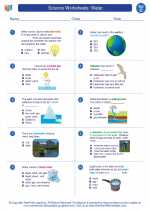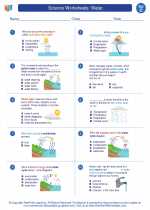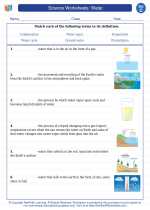Science Worksheets: Water
What is Water?
Water is a clear, odorless, tasteless liquid that is essential for all forms of life. It is made up of two hydrogen atoms and one oxygen atom, giving it the chemical formula H2O. Water is found in various forms on Earth, including oceans, rivers, lakes, and in the atmosphere as vapor.
The Three States of Water
Water can exist in three states: solid, liquid, and gas. When water is in its solid state, it is called ice. In its liquid state, it is simply referred to as water. When water is in its gaseous state, it is known as water vapor.
The Water Cycle
The water cycle describes the continuous movement of water on, above, and below the surface of the Earth. It involves processes such as evaporation, condensation, precipitation, and runoff. These processes work together to ensure that water is constantly being recycled and distributed throughout the planet.
The Importance of Water
Water is essential for life. It plays a crucial role in various bodily functions, helps regulate temperature, and serves as a habitat for many organisms. Additionally, water is used in numerous human activities, such as agriculture, industry, and household tasks.
Study Guide
.◂Science Worksheets and Study Guides Third Grade. Science Worksheets: Water.

 Worksheet/Answer key
Worksheet/Answer key
 Worksheet/Answer key
Worksheet/Answer key
 Worksheet/Answer key
Worksheet/Answer key
 Vocabulary/Answer key
Vocabulary/Answer key
